Competition Maneuver of Keluarga Pencak Silat Nusantara (VIII)
Rapid Journal, Vol. 8, No. 4 (Book 30, 2004: 44-45)
© O'ong Maryono
www.kpsnusantara.com
Defense and Attack Tactics
The pesilat standing position (sikap dua belas or standing position XII; fig. 1) signals that the pesilat is ready to fight. Moving into standing position IV (sikap empat; fig. 2), the pesilat enters into action. Although it looks as if the pesilat is in a vulnerable position, actually this is an enticement for the opponent to attack. From this stand, the pesilat besides holding out, can use the hands to carry out deadlock techniques, or even catch and lock the opponent’s hands and legs. If the opponent is not tricked into attacking, and remains passive, the pesilat can use the “dragon” blocking (tangkisan liuk; fig. 3) and quickly step back (egos belakang; fig. 4) to suddenly attack with a side kick (tendangan T; fig. 5) followed by upper cut hand strike (ayun tangan) (fig. 6), round front kick strike (tendangan serong; fig. 7) and finally round side kick strike (tanding sabit) (fig. 8).
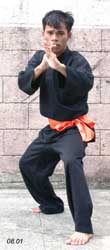 |
 |
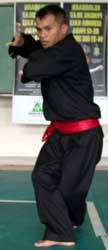 |
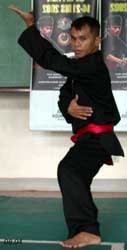 |
fig 1 |
fig 2 |
fig 3 |
fig 4 |
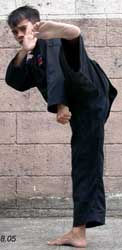 |
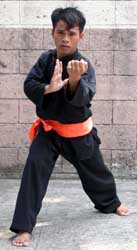 |
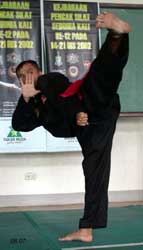 |
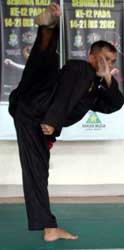 |
fig 5 |
fig 6 |
fig 7 |
fig 8 |
In closure, the striking pesilat steps back two times, turns into a flying eagle standing position (elang melayang: fig. 9 and 10) and goes back to standby position (sikap siap: fig.11) in preparation for the following pattern of movements to be discussed in the next issue.
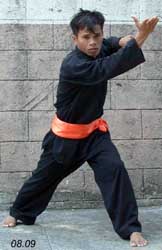 |
 |
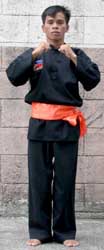 |
| fig 9 | fig 10 | fig 11 |
back to main page • back to articles from Rapid Journal • next article